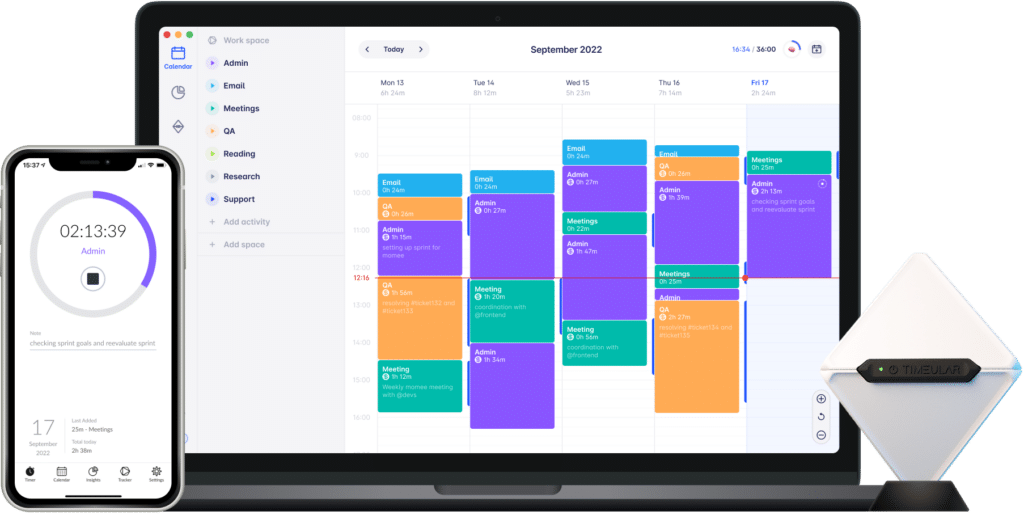Retningslinjer for tidtaking: Guiden virksomheten din trenger
Time plays a pivotal role in the concepts of productivity and success, especially within the structural organization of the workplace.
Organizations strive to optimize efficiency and enhance employee performance, and for that, they rely on the implementation of a well-crafted timekeeping policy.
Looking for a simple yet robust time tracker that will aligh with your timekeeping policy?
Work environments no longer look or work as they did in the past, the traditional models are shifting and a structured approach is needed to navigate the nuances of time management and attendance tracking.
This article delves into the intricacies of time management, exploring the significance of a comprehensive timekeeping policy and how it can motivate employee engagement, satisfaction, and organizational success.
Hva er en timeføringspolicy?
Timekeeping policy is a set of rules and structured guidelines used by employees to record, manage, and account for their working hours.
These policies include various aspects of time management, including:
- clocking in and out processes
- break and lunch periods
- overtime regulations
- methods of tracking attendance
However, the purpose of timekeeping policies goes beyond establishing rules.
They serve as a framework to ensure consistency, fairness, and compliance with labor laws. These policies are integral to fostering a productive and harmonious work environment.
Creating a timekeeping policy is now even more important with the rise of the remote work model that many companies are adopting.
Timekeeping policies play a pivotal role in addressing the unique challenges associated with distributed teams, by outlining expectations for virtual attendance, communication, and task completion to ensure remote workers remain connected and accountable.
7 benefits of a timekeeping policy
- Increased efficiency and productivity
- More accurate payroll processing
- Better resource allocation
- Full compliance with labor laws
- Improved accountability and clear expectations for everyone
- Work time and personal time are better balanced
- Establishes rules for remote work
1. Increased efficiency and productivity
A well-defined timekeeping policy helps streamline workflows and optimize productivity by providing clear guidelines on work hours, breaks, and task allocation. This contributes to the efficient use of resources and enhances overall organizational performance.
Read also: Why time management is important in a business
2. More accurate payroll processing
By implementing a systematic approach to tracking hours worked, organizations reduce the risk of payroll errors. This promotes and builds both trust and transparency in workplace relationships.
TIP: Discover the best and most accurate Payroll tracker.
3. Better resource allocation
Timekeeping data offers valuable insights into resource planning and time allocation, enabling organizations to make informed decisions about staffing levels, project timelines, and resource distribution.
By providing a clear understanding of how time is allocated across various tasks and projects, time tracking becomes a crucial tool in optimizing operational efficiency and productivity.
4. Full compliance with labor laws
Timekeeping policies are crafted to align with labor laws and regulations. This adherence helps organizations avoid legal complications, such as wage and hour violations.
5. Improved accountability for everyone
A timekeeping policy clarifies expectations around attendance and work hours for employees, making it clear what standards they need to meet.
With timekeeping practices being consistent across the board, it helps build a fair and positive work environment, as everyone follows the same rules, reducing the chances of favoritism.
Prøv Timeular gratis!
6. Balanse mellom arbeid og fritid
By establishing reasonable working hours, break times, and overtime regulations, organizations demonstrate a commitment to employee well-being, reducing the risk of burnout, improving work-life balance, and enhancing job satisfaction.
7. Establishes rules for remote work
As we saw above, in the age of remote work, timekeeping policies are needed in managing virtual teams to set clear expectations.
Anbefalt lesning:
- Forretningsproduktivitet på nytt: Ukonvensjonelle måter å ligge foran konkurrentene på.

Key elements of an efficient timekeeping policy
These are the key elements that a timekeeping policy must include:
1. Accurate recording of work hours
This involves monitoring the time an employee dedicates to work-related activities, including regular work hours, overtime, breaks, and meal periods.
TIP: Make your life easier and ensure 100% accuracy by adopting a work hours tracker.
2. Recording of breaks/meal periods
This process involves defining the length and timing of breaks and meal periods throughout the workday. It helps ensure that employees take their necessary breaks and comply with the organization’s policies on rest periods.
TIP: With a free Time Card Calculator, you can include breaks into your timesheets.
3. Recording of holidays/PTO periods
This entails policies for holidays and paid time off (PTO), outlining the methods for documenting and managing these hours (i.e. with a leave tracker).
Read also: PTO vs Vacation: What are the differences?
4. Clocking-in and clocking-out
These are the set procedures that specify how employees should record the start and end of their workday, along with instructions on the appropriate tools for logging these times (i.e. a time clock app).
5. Clarify attendance policies
This covers the rules about regular attendance and dealing with issues like being late and unexcused absences.
6. Recording overtime
The organization’s policy when handling situations where employees work beyond their regular hours (overtime) and how it is recorded.
TIP: An employee overtime tracking software tracks every extra hour worked and ensures accurate data when calculating overtime pay.
7. How to submit timesheets
This section describes the procedure for submitting time records and the steps required for their approval (Our suggestion is to use a simple timesheet app).
It also includes guidelines on the timelines and specific requirements to ensure a straightforward and efficient approval process.
Check out:
8. Enforcing time-keeping rules
This section details how the timekeeping rules are applied and what happens if they’re not followed. It describes the steps taken to ensure compliance and the possible outcomes for not adhering to these rules.
9. Remote work guidelines
Outline any flexibility in work hours or locations, especially if employees have the option to work remotely, and what are the protocols for this situation.
- Read also: The remote working essentials
10. Communication channels
Define the channels employees should use for any communication related to timekeeping policies (Check a list of top communication apps for teams).
11. Employees’ responsibilities
Define the responsibilities of employees in adhering to the timekeeping policy.
- NOTE: A timekeeping policy needs to define the legal duration of time the records will be kept in compliance with legal standards, as well as what should be done when there are discrepancies in time records that need to be corrected.

Creating an effective timekeeping policy
To build a complete and adequate timekeeping policy, consider the following essential steps:
- Assess corporate and organizational needs
It’s essential to start by understanding the specific time-related needs of an organization. Factors such as work hours, break policies, and the nature of tasks have to be considered.
- Get informed about legal requirements
Your timekeeping policy has to comply with local labor laws and regulations.
- Customize the timekeeping policy for your organization
Adjust the policy to accommodate the unique needs of your organization, paying special attention to the inclusion of remote workers and those with flexible schedules.
- Communicate the policy in a clear way
Use simple language and ensure that everyone understands the guidelines and expectations.
- Involve employees and keep them informed
Involve employees in creating or updating the policy by asking for their ideas and opinions. Offer regular training on timekeeping rules and make sure everyone knows the guidelines and any changes to them.
- Implement a user-friendly timekeeping software
Reliable timekeeping software helps streamline the tracking process. Technology ensures accuracy and efficiency, especially in environments with diverse work models, such as remote and in-person.
By incorporating these steps, your organization can create a timekeeping policy that not only ensures compliance but also contributes to a positive and productive work environment.
Looking for an easy time-keeping solution?
Best practices for implementing timekeeping policies
- “Share the policy with everyone at work so they know the rules and what’s expected. Being open about this builds trust;
- Choose the right tools to make time tracking easier. Try a few options to find the best one;
- Apply the policy fairly to all employees. Make sure the same rules and consequences apply to everyone;
- In the beginning, there might be some confusion about the new timekeeping rules. Help employees with training and resources to understand the policy;
- Keep an eye on how well the policy is working. Employee feedback is really important for making improvements;
- Make the policy easy to find and understand for everyone. Leaders should set a good example and help out;
- Regularly update the policy to match any changes in the company, industry trends, or legal rules. This keeps the policy relevant and useful.
- This version uses simpler language and breaks down the concepts into more straightforward statements for easier understanding.
The role of time-tracking tools in a company’s time-keeping policy
A time-tracking tool, such as Timeular, is an indispensable ally in the implementation of a robust time-keeping policy, basically ensuring that policy guidelines turn into tangible practices.
Time-tracking tools offer a digital framework for employees to record their work hours, breaks, and tasks, minimizing the margin for error associated with manual entry and providing a reliable foundation for policy compliance.
The automated features provided by time-tracking tools help streamline the entire process, from clocking in or out to submitting timesheets. This not only saves valuable time for employees but also enhances overall work efficiency.
Time-tracking tools also provide real-time visibility into employee activities, allowing both managers and employees to monitor their daily progress. The gathered data turns into a valuable asset that helps determine timelines, the need for extra resources, accurate project billing, etc.
Konklusjon
As companies evolve to improve efficiency and elevate employee performance, the implementation of a well-crafted timekeeping policy is incredibly important. Traditional models of work are undergoing a deep transformation at the moment, and demand a structured approach to tackle them efficiently.
This article attempts to demonstrate how a comprehensive and effective timekeeping policy can be implemented. Moving beyond mere regulations, these policies help ensure uniformity and adherence to labor laws and serve as the foundation for a balanced and collaborative work environment.
A well-defined timekeeping policy streamlines workflows and optimizes productivity, offering clear guidelines on work hours, breaks, and task allocation.
Timekeeping data provides valuable insights for resource planning, allowing informed decisions about staffing levels, project timelines, and resource distribution.
Tailor your timekeeping policies to the rhythm of your organization, foster transparency, utilize technology wisely, and ensure its continual relevance by updating and reviewing it as necessary.
Timekeeping policy FAQs
What is the purpose of a timekeeping policy?
The purpose of a timekeeping policy is to make sure that every member of the workforce knows the rules about recording their working hours. It’s a guide that helps the work days run efficiently, plan resources well, and avoid conflicts.
How can a timekeeping policy improve workforce management?
A timekeeping policy is a set of guidelines that assists a company in effectively managing its employees’ work hours. It ensures clarity about tasks and schedules, maintaining organization. Adhering to these rules helps prevent mistakes and promotes fair treatment within the organization.
- TIP: Make this process smoother with a workforce management system.
Are there any legal requirements for timekeeping policies?
Yes, there are, but these legal requirements are specific to each country and corresponding legislation.
How can I handle time off requests within a timekeeping policy?
Managing time off requests within a timekeeping policy is the best way to keep everything under control. Through an email or a project management platform, employees should know how to request time off, how much notice is needed, and what factors are considered when approving requests.
TIP: Use an employee time off tracker to increase efficiency and ensure accuracy.
What are the consequences of non-compliance with a timekeeping policy?
Not following a timekeeping policy can lead to different consequences, depending on the seriousness of the case. It can go from a warning or additional training to the loss of certain benefits, temporary suspension, or even demotion. In extreme cases, there can be a loss of salary or termination.
How can I ensure accurate timekeeping for remote employees?
To ensure accurate timekeeping for remote employees, companies use remote time tracking software designed for that, like Timeular. Most importantly, before implementing a tool, clear guidelines and expectations should be set.
How often should a timekeeping policy be reviewed and updated?
A timekeeping policy should be reviewed and updated regularly. Once a year should be the minimum frequency, but if the organization changes in structure or if labor laws are updated, revisions should be made more often.
What technology or tools can assist in implementing a timekeeping policy?
Several tools can assist in implementing a timekeeping policy effectively, from time and attendance software to human resources systems, and task management tools, among others.
Read also: Top apps to track employee attendance
Can a timekeeping policy help improve employee productivity?
A good timekeeping policy helps employees understand and manage expectations, leading to better time management. This clarity, along with promoting a healthy work-life balance contributes to improved productivity and employee satisfaction.
Are there any industry-specific considerations for timekeeping policies?
Industry-specific considerations for timekeeping policies exist since different industries have unique needs and compliance requirements. For example, the healthcare or IT industries need specific guidelines for their vastly different way of working.
Du er kanskje interessert i:


